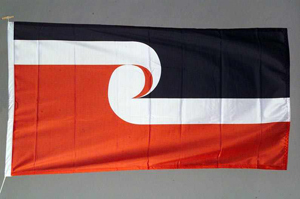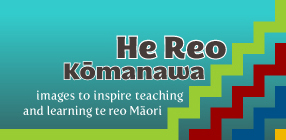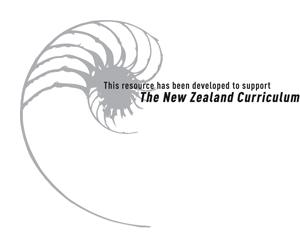
ImageTeaching and learning sequenceAdditional tasks and activities
Sample Task Sequence 10: Tino Rangatiratanga Flag (Māori Sovereignty Flag)
Digital resource from the Te Papa Collection
Image: Tino Rangatiratanga Flag (Māori Sovereignty Flag)


Copyright: Reproduced courtesy of the Museum of New Zealand Te Papa Tongarewa
Creator: Hiraina Marsden, designer, 1990, Linda Munn, designer, 1990, Jan Smith, designer, 1990
Identifiers: Museum of New Zealand Te Papa Tongarewa number ME017399. TLF resource R4716
Source: Museum of New Zealand Te Papa Tongarewa, http://www.tepapa.govt.nz
Students should be able to:
7.4 offer and respond to information and opinions, giving reasons;
7.5 read about and recount actual or imagined events in the past;
8.5 respond to selected and adapted texts in te reo Māori that are about te reo and tikanga Māori (for example, texts from recorded speeches, literature, film, newspapers, magazines, television, video, DVD, and radio).
Links to other learning areas
Social sciences, especially history; the arts
Te reo Māori text
“Ngaro te mana, ngaro te whenua, ngaro te tangata.” Nā tēnei wero ka puta ake ki te iwi whānui ki te hiki te ihi, te wana, te whakakotahitanga.
Nā ēnei whakaaro akiaki ka puta ake ēnei tikanga ki ngā iwi Māori katoa o Aotearoa, ki te whakakotahi i a tātou. Kia noho tahi tātou ko tauiwi, kia whai kiko ngā kupu o te Tiriti o Waitangi, kia whakaritea te tūranga o te tino rangatiratanga hoki. Hui katoa mai ēnei tūāhuatanga, ka whānau mai he haki motuhake.
Nā rēira, ka tukuna ngā mihi nui, ngā tino aroha ki a Hiraina Marsden, ki a Linda Munn, rātou ko Jan Smith. Nā te tokotoru nei i whakarite te āhua o te haki tino rangatiratanga. Kia ahatia? Kia tū te ihi, te wehi me te mana o te iwi Māori o Aotearoa.
“Mā pango, mā whero, ka oti.” Tihei mauriora!
Three-level guide
There are two versions of the three-level guide below, one in te reo Māori and one in English. Students who are working at levels 7–8 should use the te reo Māori version. The English version that follows is provided to increase the flexibility of this task, for example, it enables its use with students whose proficiency level is a little lower than level 7. (Note that in order to maintain an appropriate level of discussion, the whakataukī in the level three statements remain in te reo Māori.)
Ngā Ara Taumata e Toru (Three-level Guide)It is important for you to work through this guide by yourself first. When you have finished, you will discuss your answers with other students. Taumata tuatahi Tick the statements that are true. Put a cross by the statements that are not true. Be ready to support your answers with evidence from the image or the text.
Taumata tuarua Tick the statements you think the writer wants you to understand. Put a cross by the other statements. Be ready to explain your reasons by giving clues from the text.
Taumata tuatoru Tick the statements you think the writer would agree with. Put a cross by the other statements. Be ready to explain the reasons for your decisions.
|
Ngā Ara Taumata e Toru (Three-level Guide)It is important for you to work through this guide by yourself first. When you have finished, you will discuss your answers with other students. Taumata tuatahi Tick the statements that are true. Put a cross by the statements that are not true. Be ready to support your answers with evidence from the image or the text.
Taumata tuarua Tick the statements you think the writer wants you to understand. Put a cross by the other statements. Be ready to explain your reasons by giving clues from the text.
Taumata tuatoru Tick the statements you think the writer would agree with. Put a cross by the other statements. Be ready to explain the reasons for your decisions.
|
Teaching and learning sequence
When appropriate, the teacher shares the intended learning outcomes with the students and negotiates success criteria with them. The teacher and students discuss these throughout the teaching and learning sequence.
1. Viewing of image
The students view the image: Tino Rangatiratanga Flag (Māori Sovereignty Flag).
3. Reading te reo Māori text
The students read the text silently, but are free to discuss any areas of difficulty in their pairs or small groups.
4. Teacher clarification
After the reading, the teacher draws attention to new vocabulary and grammar and clarifies any remaining uncertainties.
5. Three-level guide
Each student is given a copy of the three-level guide and works through it independently, ticking the true statements and putting a cross beside the false statements at each of the three levels. Before the students begin, it is important to point out that the accuracy or otherwise of the Level 1 statements is clear from the image or from a direct statement in the text. The Level 2 statements require the students to read between the lines and draw conclusions about the writer’s intended message. The Level 3 statements require the students to interpret thought-provoking statements and select or reject these statements according to those they think the writer would agree with. At each level, the students must be ready to cite information from the photograph or the text that leads them to their decision.
6. Group discussion and mind mapping
When the students have made their own decisions and marked their papers accordingly, they work in groups of four, taking turns to explain their response to each statement and give their individual reasons for the conclusions they reached. As they work, they share responsibility for making a group mind map of the main ideas emerging from the discussion. This mind map is kept safe, as it will be used later, with additional information, in the presentation.
7. Inquiry
The students discuss other flags they know of and would like to know more about. (Most marae have a flag and there are images of other flags in this resource.) Their inquiries could be widened to include other symbols of iwi, hapū, or whānau relationships (for example, kōwhaiwhai and tukutuku patterns) and further extended to include symbols used in other cultures and contexts (for example, coats of arms and tartans). The teacher encourages the students to focus on inspiration, self-esteem, and other positive aspects of group identity.
Each group frames a written question on which to focus their inquiry and then each student makes an inquiry plan that identifies how they will seek answers to their question. This might be through reading (using the library or Internet) or museum visits and is likely to include interviewing whānau members or kaumātua. While the teacher provides support and oversight, the students undertake at least part of their inquiries for homework. They make written notes in which they record keywords and simple sentences in te reo Māori. They bring these notes to school to contribute to the next group discussion.
8. Integration of information from the inquiry and group mind maps
The students choose one of the whakataukī from the reading or (subject to teacher approval) another relevant whakataukī, as the central thought for their mind map. They share, discuss, and synthesise their information, deciding as a group how their individual contributions and the ideas on their first mind map relate to their chosen whakataukī. As the students work, the teacher circulates, encouraging the students to kōrero Māori and offering suggestions and feedback where needed.
9. Presentation
The teacher selects a method of presentation, perhaps choosing from one of the five suggestions in this resource. Another alternative is to have the students present their whakataukī along the lines of speakers on the pae:
- First speaker: Whakatau
- Second speaker: Te kaupapa
- Third speaker: Whakawhāiti ngā kōrero.
10. Reflection
The students have 10–15 minutes to reflect individually on what they have learned from this cycle of learning. They briefly record the following information in te reo Māori:
- Tuhia ngā kupu hou. (New vocabulary.)
- Tuhia tētahi whakaaro hou i akongia e koe. (One new thing you learned from your own inquiry.)
- Tuhia tētahi whakaaro hou i puta mai i tētahi hoa. (One new thing you learned from another student.)
- Tuhia ōu whakaaro mō te haki, tino rangatiratanga. (Your own feelings for the tino rangatiratanga flag.
The students reflect on the following questions, first in groups, and then as a class:
- He aha ō whakaaro mō te mahi o tēnei rā? He ngāwari? He uaua? (What was difficult? What new sentence structures can you use confidently now? What sentence structures are you still unsure of?)
- Ki hea i nāianei? (What have you achieved in terms of the success criteria? What will you need to focus on tomorrow?)
Additional tasks and activities
Depending on their students’ needs and interests, teachers may like to select from some of the following tasks and activities:
- Collect whakataukī relating to hapū and iwi solidarity.
- View and study other flag images from this collection of resources. (These include the Māori confederacy flag, trade union banner, and New Zealand company flag.)
- Design a new flag for Aotearoa.
- Design a school flag or banner and write a te reo Māori motto to go with it.


